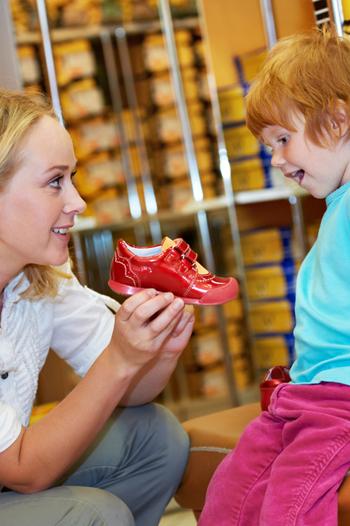Time for new shoes
Duration/age

Buying new shoes for your child gives you a chance to talk about growing and changing. You can talk about why your child needs new shoes.
Are they worn out or broken, or are they too small for growing feet?
What kind of shoes do you need? Are they for summer or winter, for inside or outside, or for everyday or special events?
Will you go to a special shoe shop or to a department store or supermarket? How will you know which size shoes to buy?
Why do feet grow, anyway?
Materials you will need
- Paper
- Pen
Alternative tools
- Shopping catalogues
Skills this activity improves
Why does this matter?
Shoe sizes relate to foot sizes, and numbers help to tell us how big something is. Using words to describe shoes helps build vocabulary. Using words to describe function builds vocabulary and reasoning. Making choices helps children express their preferences and gain self-awareness. Talking about money helps children understand about cost and value.
What does this lead to?
This activity introduces children to the concepts of how big, how small, and how much. It will help children's language development and increase their vocabulary.
Language to use
- Expensive, good value, cheap, on special
- Shoes, sandals, rubber boots, thongs, runners, sneakers
- Velcro, laces, buckles
- Leather, plastic, rubber, shiny, sparkly
- Comfortable, tight, rubbing, blister
- Toes, heels, instep, ankle
Useful tips
- Draw around your child's feet to show them how big their feet are. Take the tracing to the shops with you.
- Shoeboxes are great toys for children too.
- Remember to talk to your child in your home language.
More ideas
- Your child could draw around their feet to record their growth over time.
- Your child could measure their feet compared to other people’s feet.
- Encourage your child to ask questions and find out who has the biggest feet in their family.
- Make your own shoe shop. You will need price tags, money, shoeboxes, shoes and a customer or two.
Variation by age
Birth to two year olds
- Encourage your child to use 'dress up' shoes. Do Mum's shoes fit those little feet? Can you walk in big boots?
- Ask your child to help when putting shoes away. See if they can find the matching pairs.
Three to five year olds
- Ask your child to collect all their shoes and put them in one place, then sort them into pairs. This way they will learn to group items.
- Think of some different ways to use the old shoes. You could decorate them with exciting things like glitter or feathers. You could paint them. You could even put a plant in them and watch it grow.
- Think of some ways to make your own shoes. Maybe you could you use egg cartons or tissues boxes.
Questions to ask
- How big are your feet now?
- Are your sandals too small for you?
- Can you find some shoes that are too big for you?
- Where do your shoes go when you are not wearing them? Are they by the front door? Do you keep them in a cupboard?
Questions to ask
- Where do you put your shoes when you aren’t wearing them?
- How many different shoes do you have?
- What can we do with really worn out shoes?
- Do cardboard shoes work well? Where can you wear them?


